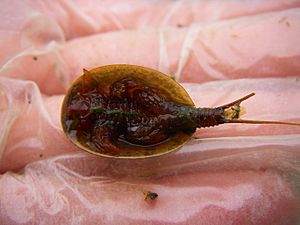Vernal pool tadpole shrimp facts for kids
Quick facts for kids Lepidurus packardi |
|
|---|---|
 |
|
| Conservation status | |
| Scientific classification | |
| Kingdom: | |
| Phylum: | |
| Subphylum: | |
| Class: | |
| Order: | |
| Family: | |
| Genus: |
Lepidurus
|
| Species: |
L. packardi
|
| Binomial name | |
| Lepidurus packardi Simon, 1886
|
|
Lepidurus packardi, also known as the vernal pool tadpole shrimp, is a special and rare type of shrimp. It's called a "tadpole shrimp" because its body shape looks a bit like a tiny tadpole. This amazing creature lives in temporary pools of water that appear after rain, mostly in California. It's an important part of its watery home.
Where It Lives
This freshwater crustacean lives only in California. It calls the special vernal pool habitat its home. Vernal pools are temporary ponds that fill with water in the wet season. They dry up later in the year.
The tadpole shrimp also lives in other temporary water spots. These include ponds, ditches, and even puddles in road ruts. It can be found in several parts of California. These areas include the Central Coast, Sacramento Valley, and San Joaquin Valley. It also lives in the southern Sierra Nevada foothills.
About 15% of the vernal pool grasslands in California are in the southeastern Sacramento Valley. This area is home to many L. packardi populations. About 28% of all known groups are in Sacramento County. You can also find them near cities like Chico and Redding. Some are in wildlife refuges too. A few have even been seen outside California, in Oregon.
What It Looks Like
The Lepidurus packardi can grow to be about 5 centimeters (2 inches) long. It has a shield-like shell called a carapace. This shell can be up to 3.5 centimeters (1.4 inches) long. It has compound eyes that help it see.
Underneath its body, it has many swimming legs. These are called phyllopods. It can have up to 48 pairs of them! At the end of its tail, called the telson, it has two pincer-like parts. These are called cercopods.
This shrimp is an omnivore, meaning it eats both plants and animals. It uses its many legs to gather food. It swims, climbs on plants, or digs in the mud. When it digs, it stirs up the mud. This makes the water cloudy. This action can change the environment of its pool. Scientists call it an "ecosystem engineer" because it changes its habitat.
Life Cycle and Reproduction
The tadpole shrimp starts its life cycle when temporary pools fill with water. Female shrimp lay eggs. Larger females lay more eggs, from 8 to 61 eggs at a time. These eggs are very tough. They can survive when the pool dries up completely.
When the pool fills with water again, the eggs hatch. This usually happens within three weeks, sometimes much faster. The baby shrimp that hatches is called a metanauplius. It grows by shedding its outer skin many times. This process is called molting. Each time it molts, it grows more swimming legs.
L. packardi takes about 38 days to become an adult. It starts to reproduce around 54 days old. It can live for about 144 days. It becomes ready to have babies when its shell is about 10 to 12 millimeters long. Sometimes, tiny flukes can live inside the shrimp. These are like tiny worms. If a shrimp has these, it won't lay as many eggs.
Protecting This Shrimp
The Lepidurus packardi is an endangered species. This means it is at risk of disappearing forever. It is listed as endangered by the United States government. It is also on the IUCN Red List, which tracks threatened species worldwide.
Many things threaten this special shrimp. Anything that harms or breaks up its vernal pool homes is a problem. Most of the original vernal pool habitats are already gone. New buildings and farms are destroying these pools. For example, building the University of California, Merced campus changed some habitat. However, plans were made to protect a large area of land too.
The pools can also be harmed if the water flow changes. If the land becomes too dry or stays wet all the time, the shrimp cannot live there. Many local groups are working to protect these important habitats. They are trying to save the vernal pool tadpole shrimp for the future.


